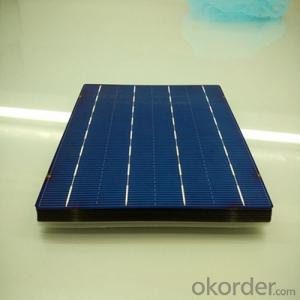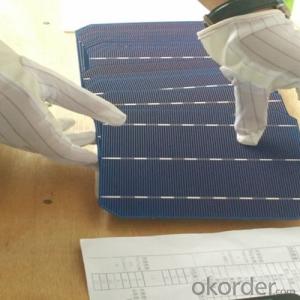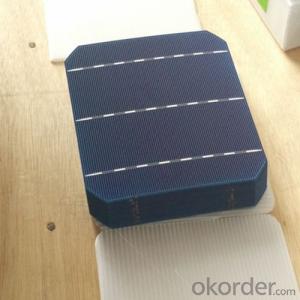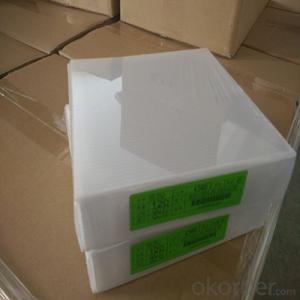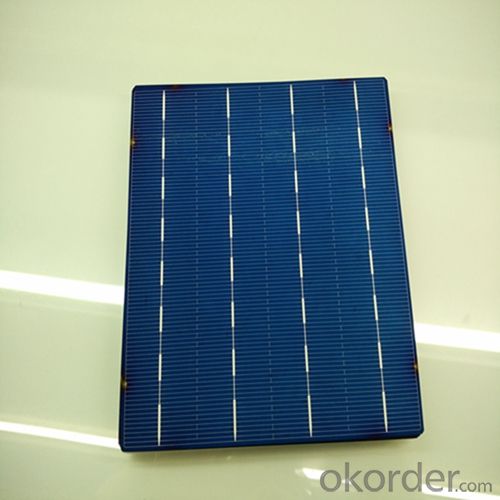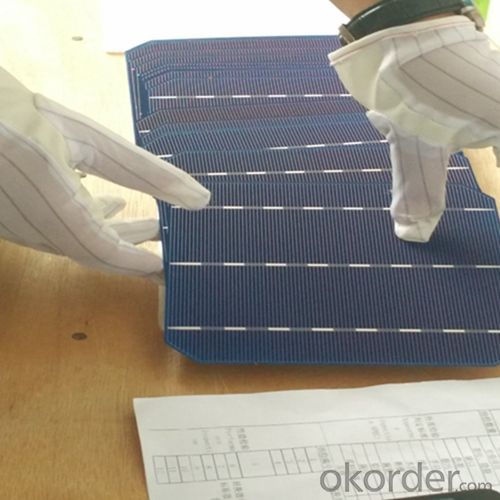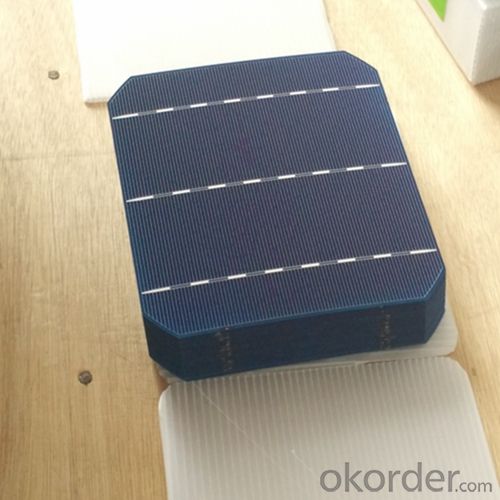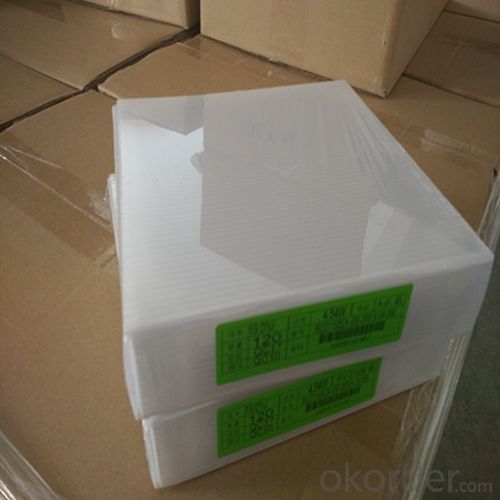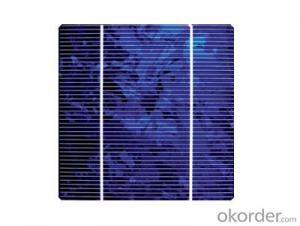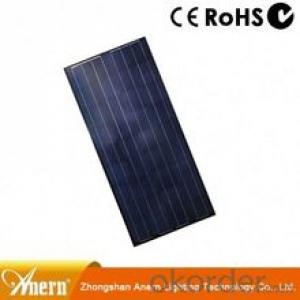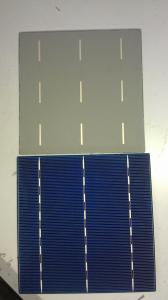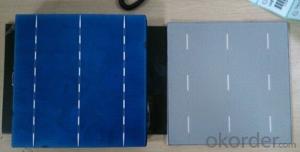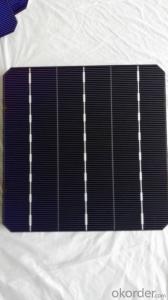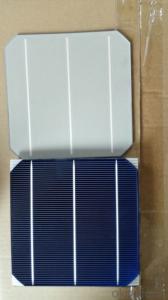Plasmonic Wholesale Poly Solar Cell 156mm x 156mm from China
- Loading Port:
- Shanghai
- Payment Terms:
- TT or LC
- Min Order Qty:
- 6500 watt
- Supply Capability:
- 6000000 watt/month
OKorder Service Pledge
OKorder Financial Service
You Might Also Like
The operation of a photovoltaic (PV) cell requires 3 basic attributes:
The absorption of light, generating either electron-hole pairs or excitons.
The separation of charge carriers of opposite types.
The separate extraction of those carriers to an external circuit.
In contrast, a solar thermal collector supplies heat by absorbing sunlight, for the purpose of either direct heating or indirect electrical power generation from heat. A "photoelectrolytic cell" (photoelectrochemical cell), on the other hand, refers either to a type of photovoltaic cell (like that developed by Edmond Becquerel and modern dye-sensitized solar cells), or to a device that splits water directly into hydrogen and oxygen using only solar illumination.Characteristic of Mono 156X156MM2 Solar Cells
You are gaining energy independence - add battery backup power for even greater energy security
The cost of electricity is only going to rise – insure against that rising cost
Adaptive cells change their absorption/reflection characteristics depending to respond to environmental conditions. An adaptive material responds to the intensity and angle of incident light. At the part of the cell where the light is most intense, the cell surface changes from reflective to adaptive, allowing the light to penetrate the cell. The other parts of the cell remain reflective increasing the retention of the absorbed light within the cell.[67]
In 2014 a system that combined an adaptive surface with a glass substrate that redirect the absorbed to a light absorber on the edges of the sheet. The system also included an array of fixed lenses/mirrors to concentrate light onto the adaptive surface. As the day continues, the concentrated light moves along the surface of the cell. That surface switches from reflective to adaptive when the light is most concentrated and back to reflective after the light moves along
Mechanical data and design
Format | 156mm x 156mm±0.5mm |
Thickness | 210μm±40μm |
Front(-) | 1.5mm bus bar (silver),blue anti-reflection coating (silicon nitride) |
Back (+) | 2.5mm wide soldering pads (sliver) back surface field (aluminium) |
Temperature Coefficient of Cells
Voc. Temp.coef.%/K | -0.35% |
Isc. Temp.coef .%/K | +0.024%/K |
Pm.Temp.coef. %/K | -0.47%/K |
Electrical Characteristic
Effiency(%) | Pmpp(W) | Umpp(V) | Impp(A) | Uoc(V) | Isc(A) | FF(%) |
18.35 | 4.384 | 0.526 | 8.333 | 0.63 | 8.877 | 78.39% |
18.20 | 4.349 | 0.526 | 8.263 | 0.63 | 8.789 | 78.54% |
18.05 | 4.313 | 0.525 | 8.216 | 0.63 | 8.741 | 78.32% |
17.90 | 4.277 | 0.524 | 8.161 | 0.625 | 8.713 | 78.04% |
17.75 | 4.241 | 0.523 | 8.116 | 0.625 | 8.678 | 77.70% |
17.60 | 4.206 | 0.521 | 8.073 | 0.625 | 8.657 | 77.36% |
17.45 | 4.170 | 0.519 | 8.039 | 0.625 | 8.633 | 76.92% |
17.30 | 4.134 | 0.517 | 8.004 | 0.625 | 8.622 | 76.59% |
17.15 | 4.096 | 0.516 | 7.938 | 0.625 | 8.537 | 76.80% |
17.00 | 4.062 | 0.512 | 7.933 | 0.625 | 8.531 | 76.18% |
16.75 | 4.002 | 0.511 | 7.828 | 0.625 | 8.499 | 75.34% |
16.50 | 3.940 | 0.510 | 7.731 | 0.625 | 8.484 | 74.36% |
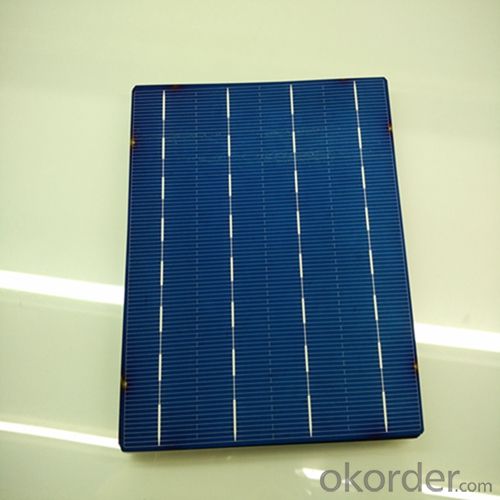
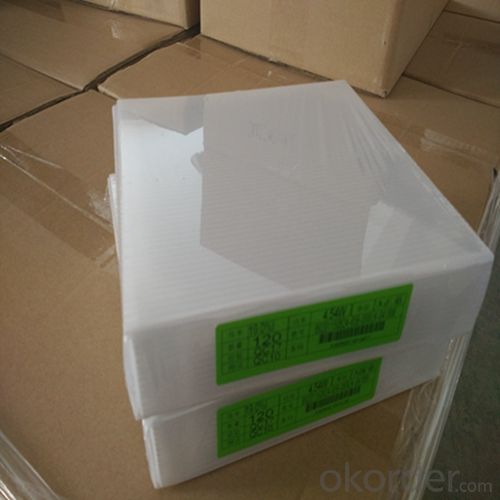
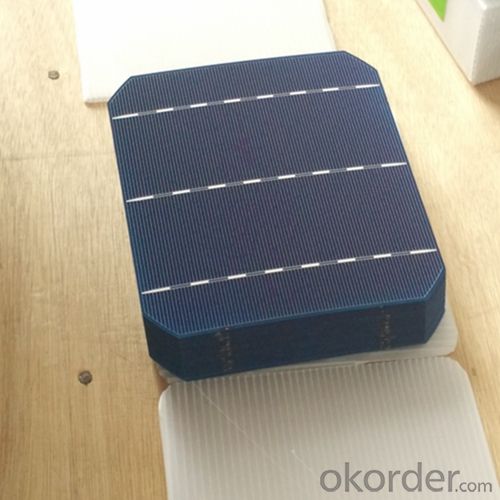
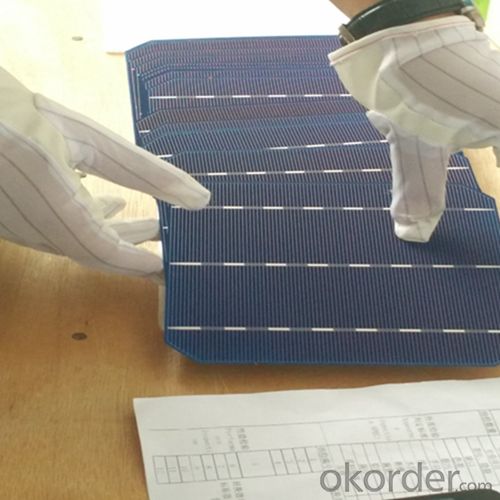
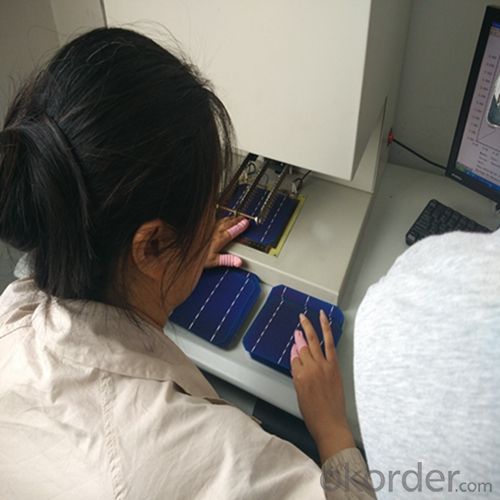 FAQ
FAQ
Q: What price for each watt?
A: It depends on the quantity, delivery date and payment terms, generally Large Quantity and Low Price
Q: What is your size for each module? Can you tell me the Parameter of your module?
A: We have different series of panels in different output, both c-Si and a-Si. Please take the specification sheet for your reference.
Q: What is your size for each module? Can you tell me the Parameter of your module?
A: We have different series of panels in different output, both c-Si and a-Si. Please take the specification sheet for your reference.
Poly solar cell 156mm manufacturing process
Cell sorting - Single Welding - string jointing - splicing (the string is welded battery slice positioning, stitching together) - intermediate test (intermediate test points: Infrared testing and visual inspection) - laminated - cutting edge - layer after appearance - after layer infrared - mounted box (usually aluminum frame) - mounted terminal box - cleaning - tests (this link also points infrared testing and visual inspection of the component level determination.) - Packaging.
(1) poly solar cell 156mm test
Because of the randomness of the solar cell manufacturing conditions, produced by the battery performance is different, so in order to effectively identical or similar battery together, it should be classified according to its performance parameters; battery test through the test cell output parameters (current and voltage) of the size of its classification. In order to improve the utilization of the battery, a battery pack made of acceptable quality.
(2) poly solar cell 156mm welding positive
Main gate line, convergence with soldered to the battery positive (negative), the convergence zone for the tinned copper strip, we use a welding machine can weld with a multi-point spot welding in the form of the main gate line. Welding heat source is an infrared lamp (using infrared thermal effect). The length of the ribbon is about 2 times the battery side length. More welding belt behind the back of the welding electrode is connected to the back of the back of the battery slice.
(3) poly solar cell 156mm in series
On the back of the battery is soldered together in series to form a module string, we are currently used process is manual, locate the battery depends mainly on a membrane with plate placement battery film grooves, groove size and battery size phase corresponding to the location of tank has been designed well, different specifications of the components use a different template, the operator use a soldering iron and solder wire will "in front of the battery," the positive electrode (anode) is welded to the "behind the battery" on the back electrode (cathode) this in turn connected in series with the positive and negative components in a string of welding wire.
- Q: Can I buy solar cells easily online?
- Yes, you can.
- Q: How do solar cells perform in high-pollution areas?
- Solar cells perform less efficiently in high-pollution areas due to the reduced amount of sunlight reaching the cells. The presence of pollutants in the air, such as smog or dust, can block and scatter sunlight, thereby decreasing the overall energy output of the solar cells. Regular cleaning and maintenance of the panels can help mitigate the impact of pollution on their performance.
- Q: Can I trust the suppliers for film solar that I found on alibaba ?
- The film solar product is a mature product in the market, so most of the information of the film solar suppliers are quite transparant, which means easy to track.
- Q: Can solar cells be used in traffic management systems?
- Yes, solar cells can be used in traffic management systems. They can be utilized to power various components of the system such as traffic lights, sensors, and cameras. Solar cells provide a renewable and sustainable source of energy, reducing the reliance on traditional power sources and helping to reduce carbon emissions. Additionally, solar-powered traffic management systems can be installed in remote areas where access to electricity grids may be limited or non-existent.
- Q: We are currently promoting our one of our solar cells seriers, which is the 156mmx156mm 6inch,2BB/3BB polycrystalline/multi solar cells,mono solar cell,made in Taiwan/Germany, please feel free to contact me if any interest.
- I searched online for the product you are promoting, but can not find much useful information, maybe it is better that you can send me a price list?
- Q: Can solar cells be used in powering medical devices?
- Yes, solar cells can be used to power medical devices. Solar cells can convert sunlight into electricity, which can then be used to directly power or recharge batteries of various medical devices such as pacemakers, insulin pumps, and portable diagnostic equipment. This renewable energy source offers a sustainable and efficient solution for powering medical devices, especially in remote or resource-limited areas where access to electricity may be limited.
- Q: How do solar cells perform in areas with limited sunlight?
- Solar cells generally perform less efficiently in areas with limited sunlight. This is because solar cells rely on sunlight to convert light energy into electricity. In areas with limited sunlight, such as regions with frequent cloud cover or high latitudes, solar cells may generate less electricity or even fail to produce any power at all. However, advancements in solar cell technology, such as the development of more efficient and sensitive materials, have improved their performance in low-light conditions to some extent.
- Q: Can solar cells be used in sports arenas?
- Yes, solar cells can be used in sports arenas. They can be installed on the roofs or facades of the arenas to harness solar energy and generate electricity. This renewable energy source can help to power the stadium's lighting, scoreboards, and other electrical systems, reducing the reliance on non-renewable energy sources and lowering the carbon footprint of the facility.
- Q: Can solar cells generate electricity on cloudy days?
- Yes, solar cells can generate electricity on cloudy days, although their efficiency is reduced compared to sunny days. The cells can still convert the diffuse sunlight that penetrates through the clouds into electricity, albeit at a lower rate.
- Q: Can solar cells be used in public transportation?
- Yes, solar cells can be used in public transportation. They can be integrated into vehicles such as buses, trams, or trains to harness solar energy and power various onboard systems. Solar panels on the roof can generate electricity to charge batteries, power lighting and ventilation systems, or even propel the vehicle itself. This helps reduce reliance on traditional fuel sources and decreases carbon emissions, making public transportation more sustainable and environmentally friendly.
Send your message to us
Plasmonic Wholesale Poly Solar Cell 156mm x 156mm from China
- Loading Port:
- Shanghai
- Payment Terms:
- TT or LC
- Min Order Qty:
- 6500 watt
- Supply Capability:
- 6000000 watt/month
OKorder Service Pledge
OKorder Financial Service
Similar products
Hot products
Hot Searches
Related keywords
